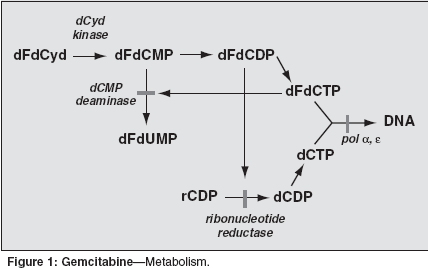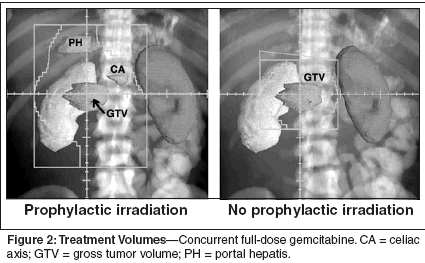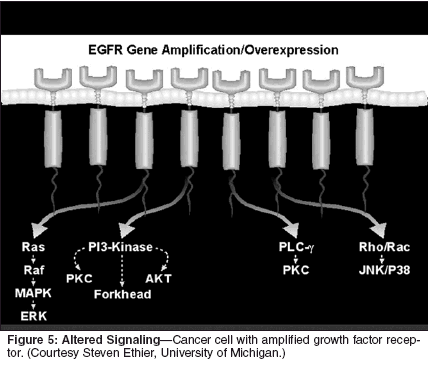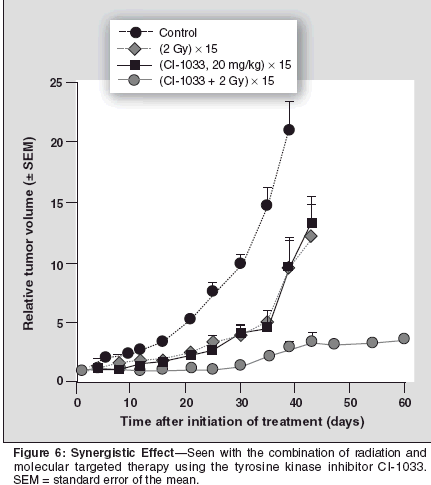Radiation Sensitizers and Targeted Therapies
Chemotherapeutic agents that are highly responsive to ionizing radiationand enhance the effectiveness of radiation treatment are termedradiation sensitizers. Radiation sensitizers act in a number of ways tomake cancer cells more susceptible to death by radiation than surroundingnormal cells, and several such compounds are now available forthe treatment of solid tumors. This review discusses the biology thatunderlies chemotherapy and radiation interactions for oneradiosensitizerSMQ-8212-SMQgemcitabine (Gemzar). It also provides a brief assessmentof how to modify treatment regimens for various cancers to maximizethe radiosensitization potential of gemcitabine in order to furtherincrease efficacy. Newer molecularly targeted agents and their antitumorpotential as monotherapy or in combination with radiation arealso reviewed.
ABSTRACT: Chemotherapeutic agents that are highly responsive to ionizing radiationand enhance the effectiveness of radiation treatment are termedradiation sensitizers. Radiation sensitizers act in a number of ways tomake cancer cells more susceptible to death by radiation than surroundingnormal cells, and several such compounds are now available forthe treatment of solid tumors. This review discusses the biology thatunderlies chemotherapy and radiation interactions for oneradiosensitizerSMQ-8212-SMQgemcitabine (Gemzar). It also provides a brief assessmentof how to modify treatment regimens for various cancers to maximizethe radiosensitization potential of gemcitabine in order to furtherincrease efficacy. Newer molecularly targeted agents and their antitumorpotential as monotherapy or in combination with radiation arealso reviewed.
Chemotherapeutic agents thatare cytotoxic to tumors act bya variety of mechanisms.Those that are highly responsive toionizing radiation and enhance the effectivenessof radiation treatment aretermed radiation sensitizers. Radiationsensitizers act in a number ofways to make cancer cells more susceptibleto death by radiation than thesurrounding healthy cells. Several radiationsensitizers are now availablefor the treatment of solid tumors. Thisreview will discuss the biology thatunderlies chemotherapy and radiationinteractions for one radiosensitizer-gemcitabine (Gemzar)-and will providea brief assessment of how tomodify treatment techniques by takingadvantage of the natural historyof the disease. In addition, the reviewwill attempt to offer insight into trialdesign modifications for variouscancers and will discuss the conceptof molecular targeted therapy forimproved efficacy of radiationsensitizers.The rationale for combining chemotherapyand radiation includes thenotion that chemotherapy may eradicatesites of disease that have yet toappear or manifest themselves. If chemotherapycan, in fact, eradicate malignantcells, then the interaction betweenthe chemotherapeutic agent andradiation is not really necessary. However,it is important to understand thatthe addition of another agent to radiationwill only improve the therapeuticindex if the tumor cell kill is increasedmore than the increase in toxicity toneighboring normal cells. Indeed, antitumoreffects should be greater thanthe toxic side effects of the addedtherapy.Most cancer treatment now uses thecombined approach of conventionalchemotherapy with radiation. Basedon cumulative evidence from numerousrandomized clinical trials, thiscombined approach shows an in-creased survival benefit in the treatmentof locally advanced cancers ofthe head and neck, lung, esophagus,stomach, pancreas, and rectum. Nonetheless,the underlying mechanism forhow chemotherapeutic agents act asradiosensitizers remains largely unknown.We are only now beginning tounderstand how to use chemotherapyand radiation to optimize treatment,overall survival, and quality of life.What is known about one of the morewidely used radiosensitizing agents,gemcitabine, is discussed below.

GemcitabineGemcitabine (2'2'-difluoro-2'-deoxycytidine) is a nucleoside analogof cytosine arabinoside with clinicalactivity against solid tumors such aspancreas and non-small-cell lungcancers.[1,2] It is a prodrug that ismetabolized by the enzyme deoxycytidinekinase, which phosphorylatesthe analog to the monophosphateand diphosphate and then to 2'2'-difluoro-2'-deoxycytidine triphosphate(dFdCTP) (Figure 1).[3] The 5'-diphosphateand triphosphate forms are activemetabolites, with dFdCTP as the toxicmetabolite chiefly responsible for killingcells and producing cytotoxicity.As is common with manychemoradiation agents, the mechanismthat produces cytotoxicity is oftennot the same mechanism that increasesradiation sensitivity. Early invitro studies showed that neither theincreased pools of dFdCTP (the metabolitethat causes cytotoxicity) northe amount of gemcitabine in cellscorrelated well with the increase inradiation sensitivity. On the otherhand, gemcitabine radiosensitizationrequired that cells be depleted of dATPand exhibit a redistribution into Sphase.[4] In addition, gemcitabine didnot affect either radiation-inducedDNA damage or repair. Our workinghypothesis is that sensitization occursunder S-phase progression on a damagedDNA template-one that hasbeen damaged due to gemcitabine-induceddepletion of dATP pools thatlead to misincorporation and misrepairof incorrect bases after radiation andultimately promotes cell death.[4]In fact, gemcitabine is a very potentradiation sensitizer under cytotoxicconditions. In HT29 human coloncancer cells, exposure to 3 μmol/Lgemcitabine for 2 hours resulted inapproximately threefold increase inradiosensitivity.[5] Even nontoxicdoses of 10 nmol/L produced detectablesensitization at 24 hours.[6]Plasma concentrations of 20 μmol/Lare routinely achieved in patients receivinggemcitabine therapy.[7]In the clinical setting, this informationcan be used to provide rationaldosing regimens that take advantageof the dual properties of the drug: itscytotoxicity as well as its radiosensitivity.First of all, the findings showthat radiosensitization can be achievedunder noncytotoxic conditions andthat doses of gemcitabine well belowthose required to achieve cytotoxicitymay be used. Therefore, if the drug isgiven twice weekly at doses of 10 to50 mg/m2, it would provide radiationsensitivity for the entire week and permitsensitization of all radiation fractions.Note that plasma level doses of≥ 1 μmol/L (obtained with these lowergemcitabine doses) can be toleratedunder a twice-weekly schedule comparedwith a weekly schedule. In addition,these lower doses are sufficientto provide continued radiosensitization.If the goal is to produce cytotoxicitywith radiosensitization, a chemotherapeuticdose (1,000 mg/m2) can beadministered, which should radio-sensitize radiosensitizefor at least part of the week.To determine whether gemcitabine isbeing administered to a patient underconditions that produce radiosensitization,it may be of interest to assesssimultaneous intracellular dATP poolsand to determine the cell cycle distributionin tumor biopsies.Gemcitabine as aRadiosensitizerIn vivo studies were conducted togain further insight into how the dosingschedule of gemcitabine could affectthe therapeutic index. One studyincluded an intraperitoneal dose ofgemcitabine at 50 mg/kg given eitherbefore or after a single 25-Gy fraction.[8] Regrowth delays were longestwhen gemcitabine was administered24 to 60 hours before irradiation,and were in agreement with earlierpreclinical studies.[5] In addition, asingle 5-mg/kg dose, which was foundto have a minimal effect on tumor regrowth,was able to enhance the responseto radiation,[9] confirming thatminimally cytotoxic doses ofgemcitabine are radiosensitizing aspredicted by earlier preclinical results.The same approach has recentlybeen taken for the treatment of headand neck cancers with the use ofgemcitabine as a radiosensitizer. Initialclinical studies used relatively lowdoses of gemcitabine given onceweekly for patients with untreatedstage IV squamous cell cancer of thehead and neck. Treatment with weeklygemcitabine (at escalating doses beginningat 300 mg/m2) and standardexternal beam radiation (70 Gy in2-Gy fractions using the shrinkingfieldtechnique) was used.[10] In thistrial, severe acute and late mucosal andpharyngeal-related dose-limiting toxicityrequired de-escalation ofgemcitabine in successive patient cohorts.Even 50 mg/m2 gemcitabinegiven once weekly was not tolerable.Subsequent preclinical studies usinga mouse model for oral toxicity revealedthat equitoxic combinations oftwice-weekly gemcitabine with radiationwere significantly more effectiveagainst flank tumors than once-weeklygemcitabine. A clinical trial was designedusing this concept and is cur-rently accruing patients.Is it also possible to take advantageof the cytotoxic properties ofgemcitabine as well as its radiosensitizingproperties? Based on studiesperformed in cell culture, it is clear thathigher doses of gemcitabine are bothradiosensitizing and highly cytotoxic.In fact, the drug could produce profoundradiosensitizing effects at dosesof 1,000 mg/m2. Therefore, a full doseof gemcitabine along with a full doseof large-field radiation should be usedwith caution because the combinationis extremely powerful and may leadto unacceptable toxicity.Combined Cytotoxicity andRadiosensitivity of GemcitabineA different approach has beentaken for the treatment of pancreaticcancer in a phase I dose-escalationtrial. Here, a standard dose ofgemcitabine was combined with alower radiation dose in order to radiatethe primary tumor alone withoutthe inclusion of normal-appearing regionallymph nodes in patients withunresectable or incompletely resectedadvanced pancreatic cancer.[11] Thereduced radiation dose was used forsafety purposes in order to reduce therisk of side effects. In addition, thetreatment volume was reduced in orderto target the primary tumor, andchemotherapy was used to control occultdisease. Therefore, the study attemptedto maximize the use of boththerapies in order to obtain an optimalresponse by limiting the radiationportals.Gemcitabine was delivered at1,000 mg/m2 weekly every 28 days,and the radiation dose was escalatedwith a starting dose of 24 Gy in 1.6-Gy fractions. The fractions were escalatedby increasing the fraction sizeby 0.2 Gy and keeping the durationconstant at 3 weeks. An example ofthe treatment volume used in the doseescalationtrial is shown in Figures 2and 3 (right panels) as compared withthe volume generally used for prophylacticradiation shown on the left.Results of this phase I study[11]showed that hematologic toxicitieswere no different than those reportedin other studies using gemcitabinealone.[1] Therefore, with the use ofsmall radiation volumes, the toxicitywas quite tolerable.[11] The meanweight loss was only about 1%, andthe recommended dose was 36 Gy infifteen 2.4-Gy fractions. With a medianfollow-up of 22 months for 37patients, the overall median survivalwas 11.6 months (range: 9.9-19.2months). Moreover, three patientshave survived more than 20 months,including one with biopsy-proven livermetastases.


Another study evaluated weeklygemcitabine at doses of 350 to500 mg/m2 (for 7 weeks) with largefieldexternal-beam radiation at dosesof 30 to 33 Gy in 10 to 11 fractionsdelivered over the first 2 weeks. In thistrial, the combination produced significantnonhematologic side effects inover half of the 18 patients (nausea/vomiting and dehydration; 44% requiredhospitalization).[12] The difference,however, between this weeklydose trial and the previously describeddose-escalation trial includes the factthat radiation volumes were different,as was the dose per fraction. Therefore,it is possible that the use of largevolumeradiation therapy with astrongly cytotoxic drug such asgemcitabine may not be tolerable forprolonged dosing schedules. On theother hand, radiation therapy usingtargeted volumes that identify thegross tumor volume with a modestmargin allows cytotoxic chemotherapeuticagents to be tolerated at muchhigher doses. As such, decreasing theradiation volume is a way to intensifyboth therapies when used in combination.


Intensifying CytotoxicityWith RadiosensitivityOne may wonder if it is possiblethen to intensify systemic therapy. Onepreclinical study suggests that treatmenteffects may be intensified byusing a doublet combination plus radiation.Using two human pancreaticcancer cell lines, cells were exposedto three different treatment schedulesto mimic clinical treatment regimensprior to radiation therapy: (1) sequentialdosing of gemcitabine for 2 hoursfollowed by cisplatin for 2 hours; (2)gemcitabine for 2 hours followed bya washout, a replenishment of mediumfor 24 hours, and then cisplatin for 2hours; or (3) gemcitabine for 24 hourswith concurrent cisplatin for the last 2hours.[13] With these regimens, it wasfound that cisplatin did not produceradiosensitization. However, the drugwas synergistically cytotoxic withgemcitabine without compromisinggemcitabine-mediated radiosensitization.As a result, a phase I trial ofcisplatin and gemcitabine plus radiationin patients with locally advancedunresectable cancer of the pancreas isbeing developed.Molecular Targeted TherapiesAre there other potential radiosensitizersthat have not yet been explored?Studies of how normal cellsintegrate signals to affect a responsewould suggest that there are. For example,a quick glance at the growthfactor receptors and their intracellularactivation pathways illustrates thatmany receptors are involved in signalintegration, including the erbB2 familyof receptors, the insulin growth factorreceptor, fibroblast growth factorreceptor, and the integrins (Figure 4).With such careful integration, undernormal circumstances no single pathwayappears to dominate.With the onset of abnormal growth,however, many cells will overexpressa single growth factor family, such asthe epidermal growth factor receptor(EGFR), during carcinogenesis (Figure5). When this occurs, cell signalingis no longer integrated but drivenby one single growth factor receptorpathway. In some cases, overexpressionis the activating lesion. Whilesome cancerous cells overexpress oneor more growth factor receptors,overexpression does not always indicatean activating lesion. Therefore,performing routine immunohistochemicalprocedures following cellinhibition will not consistently indicatewhich tumors are actually beingdriven by one or more aberrantpathways.Instead, it appears that one of thebetter ways is to perform a biopsy inadvance of administering a drug andthen another following drug administrationto determine if a specific pathwayhas been suppressed. Nonetheless,biopsies, when possible, are nota fair measure of change; biopsies representonly a single point in time anddo not adequately monitor the changein a tumor or in the normal tissue duringthe course of treatment. Therefore,clinical performance should involve anumber of different sources of datafrom clinical specimens and from newtests, such as magnetic resonancespectroscopy, to permit the measurementof tissue changes (eg, metabolitechanges) over time.Molecularly targeted therapy canbe advantageous if it produces a selectivecytostatic effect. This couldblock tumor cell growth during a protractedcourse of radiation, thereby increasingthe effectiveness of treatment.In addition, even modest radiosensitization,as long as it is selective, couldbe beneficial. Several groups havetaken advantage of this concept byintroducing a farnesyltransferase inhibitorthat inactivates the Ras pathways.While only modest radiosensitizationin culture has been observedwith farnesyltransferase inhibitors-enhancements of 1.2 to 1.3 as comparedwith values of 1.8 to 3 with chemotherapeuticagents[14]-it is conceivablethat this extent of selectivitycould produce benefit when repeated30 to 40 times during a course of radiation.More importantly, if the cytostaticeffect of a molecular targetedtherapy is further combined with thecytotoxic effect of a chemotherapeuticagent, an extremely potent and favorableoutcome may arise.Some of the recently pursuedtargeted therapies include CI-1033,gefitinib (Iressa), and erolitnib(Tarceva). These are all 4-anilinoquinazolineswith the ability to inhibittyrosine kinase receptors such asEGFR and HER2 receptor kinases.[15] Their antitumor activitiesgenerally revolve around their abilityto reversibly or irreversibly inhibit oneor more tyrosine kinase receptors andthus limit or inhibit tumor cell growth.While gefitinib and erlotinib are reversibleinhibitors that exhibit receptorselectivity, CI-1033 appears to bindall tyrosine kinase receptors irreversiblyand thus may have a larger spectrumof activity.

An example of the synergistic relationshipbetween CI-1033 and radiationtherapy has been demonstrated inan animal model in which LoVo coloncarcinoma tumors were implantedinto the flanks of nude mice (TSLawrence, unpublished data, 2002).Following implantation, the mice weretreated with either radiation therapy(2 Gy for 15 fractions), CI-1033(20 mg/kg/d for 5 days a week, for atotal of 15 treatments), radiation plusCI-1033, or no treatment. Figure 6shows the relative tumor volume forall treatment groups and illustrates thesynergistic effect found with combinationtherapy. Whether the results aredue to the cytostatic or cytotoxic effectsof CI-1033 remain unclear; however,analysis of tissue sectionsshowed the greatest cell death occurredwith combination treatment.Other targeted therapies includeinhibitors of other specific growth factortyrosine kinases. In addition, genetherapy is being used for the treatmentof solid tumors. With gene therapy,specific genes, such as those expressingcytokines or suicide genes, are in-troduced into tumor cells. In somecases, a radiation-sensitive promoteris placed upstream of the gene and,thus, activated with the delivery of ionizingradiation. In other cases, the genedelivery is used to generate high localconcentrations of chemotherapy or acytokinelike tumor necrosis factor.While these models are still in the earlystages of testing, they show promise.The question remains whether targetedmolecular therapy can increasethe therapeutic index of standardtherapy. While data remain inconclusive,it is clear that these targeted therapiesdo not rely on pure sensitizationand, thus, are not being used for suchpurposes. Instead, it is more importantthat these therapies kill the primarytumor while sparing the normal tissues.The therapeutic index should affectthe tumor more than it affects normaltissue.ConclusionsIt is becoming increasingly clearthat to improve patient quality of life,delivery of all therapies should focuson a more targeted approach that limitstoxicity and preserves normal tissuefunction. Future research shouldfocus on methods of individualizingcancer therapy. These may be basedon rapid assays that evaluate mechanismsof resistance or the use of selectiveinhibitors of one or more tumorpopulations for inclusion in combined-modality protocols. Thus, thefuture of clinical trial design with radiotherapymust include chemotherapeuticand/or biologic therapies andways to both analyze the drug andevaluate the therapeutic index, not justthe radiosensitizing properties of theadded agent. Techniques such as magneticresonance spectroscopy will assistin the measurement of intracellu-lar metabolites over time in order tomonitor changes in the disease. Somechemotherapies, such as gemcitabine,fluorodeoxyuridine, and cisplatin, allactive in the micromolar range, willrequire positron emission tomographyimaging of the drug. Their activity willrequire the analysis of key enzymessuch as ribonucleotide reductase in thecase of gemcitabine or thymidylatesynthase in the case of fluorodeoxyuridine.To appropriately use many of thesepotentially potent newer agents, thenatural history of the disease shouldbe taken into consideration. This willhelp identify how each drug can beadministered. In the case ofgemcitabine, the delivery can bemodulated to emphasize its cytotoxicnature (a delivery that is appropriatefor cancers with a high likelihood ofmetastases, such as pancreatic cancer),or emphasize its radiosensitizing property(such as with the delivery of verylow-dose gemcitabine).With radiotherapy, targeted treatmentcan be accomplished by threedimensionalconformal therapy thatproduces a truly targeted dose of radiationto a more site-specific location.The present and the future of truly targetedtherapy require that importantimprovements be incorporated into thetreatment regimens with a cautious butsystematic approach.
Disclosures:
The author(s) have no significant financial interest or other relationship with the manufacturers of any products or providers of any service mentioned in this article.
References:
1.
Burris HA 3rd, Moore MJ, Andersen J, etal: Improvements in survival and clinical benefitwith gemcitabine as first-line therapy forpatients with advanced pancreas cancer: A randomizedtrial. J Clin Oncol 15:2403-2413,1997.
2.
Sandler AB, Nemunaitis J, Denham C, etal: Phase III trial of gemcitabine plus cisplatinversus cisplatin alone in patients with locallyadvanced or metastatic non-small cell lung cancer.J Clin Oncol 18:122-130, 2000.
3.
Heinemann B, Hertel LW, Grindey GB,et al: Comparison of the cellular pharmacokineticsand toxicity of 2â²2â²-difluorodeoxycytidineand 1-beta-D arabinofuranosylcytosine.Cancer Res 48:4024-4031,1988.
4.
Lawrence TS, Eisbruch A, Shewach DS:Gemcitabine-mediated radiosensitization.Semin Oncol 24(suppl 7):S7SMQ-8211-SMQ24-28, 1997.
5.
Lawrence TS, Chang EY, Hahn TM, etal: Delayed radiosensitization of human coloncarcinoma cells after a brief exposure to 2â²2â²-difluoro-2â²-deoxycytidine (gemcitabine). ClinCancer Res 3:777-782, 1997.
6.
Shewach DS, Hahn TM, Chang E, et al:Metabolism of 2â²2â²-difluoro-2â²-deoxycytidineand radiation sensitization of human colon carcinomacells. Cancer Res 54:3218-3223, 1994.
7.
Abbruzzese JL, Grunewald R, Weeks EA,et al: A phase I clinical, plasma, and cellularpharmacology study of gemcitabine. J ClinOncol 9:491-498, 1991.
8.
Milas L, Fujii T, Hunter N, et al: Enhancementof tumor radioresponse in vivo bygemcitabine. Cancer Res 59:107-114, 1999.
9.
Mason KA, Milas L, Hunter NR, et al:Maximizing therapeutic gain with gemcitabineand fractionated radiation. Int J Radiat OncolBiol Phys 4:1125-1135, 1999.
10.
Eisbruch A, Shewach DS, Bradford CR,et al: Radiation concurrent with gemcitabinefor locally advanced head and neck cancer: Aphase I trial and intracellular drug incorporationstudy. J Clin Oncol 19:792-799, 2001.
11.
McGinn CJ, Zalupski MM, Shureiqi I,et al: Phase I trial of radiation dose escalationwith concurrent weekly full-dose gemcitabinein patients with advanced pancreatic cancer. JClin Oncol 19:4202-4208, 2001
12.
Wolff RA, Evans DB, Gravel DM, et al:Phase I trial of gemcitabine combined with radiationfor the treatment of locally advancedpancreatic adenocarcinoma. Clin Cancer Res7:2246-2253, 2001.
13.
Symon Z, Davis M, McGinn CJ, et al:Concurrent chemoradiotherapy withgemcitabine and cisplatin for pancreatic cancer:From the laboratory to the clinic. Int JRadiat Oncol Biol Phys 53:140-145, 2002
14.
McKenna WG, Muschel RJ, Gupta AK,et al: Farnesyltransferase inhibitors as radiationsensitizers. Semin Radiat Oncol 12(suppl2):27-32, 2002
15.
Lawrence TS, Nyati MK: Small-moleculetyrosine kinase inhibitors asradiosensitizers. Semin Radiat Oncol 12(suppl2):33-36, 2002.